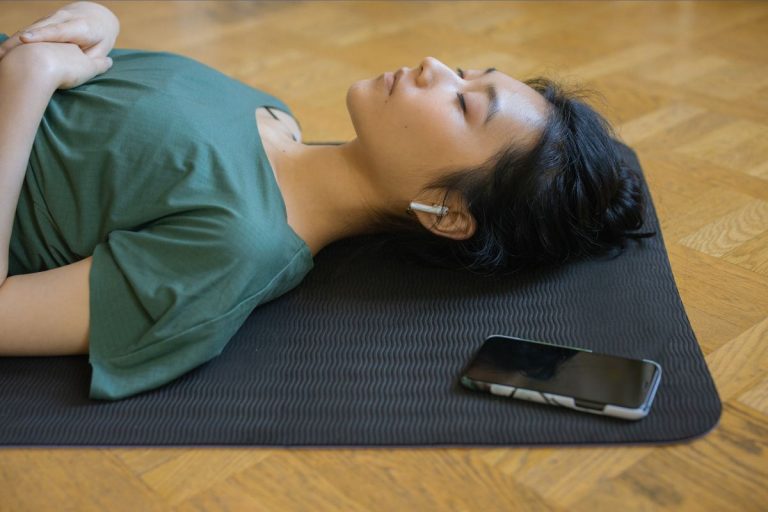People have been sleeping on the floor for thousands of years, and that is not a new concept. However, as time went by, and we came up with new technologies and lifestyles, people moved from sleeping on the floor up to sleeping on beds. Nevertheless, some cultures still practice floor sleeping, or even ground sleeping, due to the numerous benefits it is believed to have.
But, when it comes to Western cultures, sleeping on the floor is an outdated concept. So when people think of placing their mattress on the floor rather than a bed frame, they come across a lot of questions, mostly regarding the benefits of such an arrangement.
To answer some of the most common questions and to clear any doubts, in the following paragraphs we’ll take a look at the concept of placing a mattress on the floor; should you do it and what are the benefits-drawbacks of the concept. So, let’s get started!
Placing A Mattress On The Floor: Benefits, And Drawbacks
Benefits
- Back pain improvement – by placing the mattress on the floor, you’re more likely to take full advantage of its back pain reduction properties and abilities. Sleeping on a mattress that is placed directly onto the perfectly even floor can promote proper spinal alignment and help you keep a neutral position while sleeping. This can, in turn, reduce back pain and help provide pain relief in conditions like sciatica, scoliosis, etc.
- Blood circulation improvement – because the mattress becomes more firm and supportive when placed on a flat surface, like the floor, it is more likely to improve the blood circulation. This occurs because the mattress on the floor is completely flat and supportive of the body, relieving pressure off pressure points and allowing the body (muscles and tissue) to receive more blood. Proper blood flow, or proper blood circulation, can make you less susceptible to diseases, fat deposition, heart issues, etc.
- Space-friendly – it is pretty obvious that a mattress on the floor would use less space than a mattress on a bed frame. This especially applies to smaller areas or bedrooms, where the whole bed frame setup uses almost the whole room’s space. So, if you want to keep your bedroom spacious, placing a mattress on the floor will do the trick. It will also make your room walls seem higher, and the room overall larger and brighter.
- Cost-friendly – deciding to place your mattress on the floor will save you a ton of money. Bed frames and bed foundations are incredibly expensive. So, instead of spending all of your money on a good bed platform, you can focus on finding the perfect mattress. This way you can spend a little more on a good mattress, instead of budget-buying both the mattress and the bed frame, and compromising the quality over price.
What We Recommend:
- 7 Best Floor Mattress in 2023
- 10 Best Foldable Mattresses (2023 Updated)
- 10 Best Air Mattress in 2023: We Only Recommend The One’s Best For Your Money
- The Mattress on Floor Vs. Bed Frame (Pros And Cons of Each)
Drawbacks
- Allergic reactions – floors are probably the dirtiest surface in a home. They are the gathering place of all dust, bugs, mites, and other harmful and allergy-triggering particles. The majority of people don’t take their shoes off when at home, so they bring in even more dirt, mites, and allergens inside the home. So, you can see how sleeping so close to the floor can trigger different allergy reactions, from skin rash and redness to breathing troubles, runny nose, and irritated eyes.
- Back pain worsening – some people might experience back pain relief when sleeping on the floor, while others experience the complete opposite. Studies have shown that patients with chronic or non-specified back pain issues experience worsening of pain when sleeping on firm floor mattresses. The studies on this topic are outdated, but they still provide enough evidence to considering sleeping on the floor a big no-no in case of chronic back pain.
- Hypothermic effect – by placing your mattress directly on the floor and sleeping on it, you’re risking the development of the hypothermic effect. This means that the temperature close to the floor is cooler than the rest of the room. And surely, it would be very nice during hot summer days, but during the colder months, you could be risking your health and improving the chances of developing the flu or cold. Sleeping on the floor will reduce your body temperature and make it hard for you to warm up.
- Mattress damage and warranty – mattresses are built with bed frames and bed foundations in mind; they’re supposed to have a platform where they’ll rest. So, your mattress warranty does consider and include the placement of your mattress in terms of warranty application and validity. No company will cover mattress damage if the mattress was placed on the floor or the ground. Furthermore, every mattress company advises right away against sleeping on the floor due to dust, mites, bugs, mold, mildew, etc.
What To Consider Before Placing The Mattress On The Floor?
The Type Of Floor
If you’re thinking of placing the mattress on the floor, make sure to consider the type of flooring. The best floor surfaces include hardwood, tile, floor mats, rugs/carpet, and Japanese-style mats known as tatami. It is essential you avoid surfaces like natural fiber rug or plywood because they retain moisture and increase the risk of mold and mildew development.
The Type Of Mattress
When buying a mattress to sleep on the floor, it is essential you choose a type of mattress that can be used without a bed frame. Luckily, the majority of mattresses can be used on their own, but we recommend you focus on hybrid and latex mattresses since they provide the best harmony of comfort and support.
Your Health Status
If you have allergies that can be easily triggered by dust, mites, mold, and other harmful particles, you should reconsider sleeping on the floor. Moreover, you should also consider the status of your back pain and back condition before you decide to place your mattress on the floor.
And, if you’re someone who has a hard time getting out of bed and requires assistance, then you should definitely ditch the mattress on the floor idea.
Bed Bugs
Before you place your mattress on the floor, make sure to consider the following things; whether you walk around the home in shoes, and bed bugs. We’re more likely to bring bed bugs into our homes if we walk around in shoes.
And so, bed bugs are more likely to end up in the mattress if the mattress is on the floor. So, bear in mind that such bugs can easily enter the mattress if it’s not elevated above the floor, where the bed frame usually acts as potential protection and barrier from bed bugs and other unwanted guests.
Also Read:
- Can Bed Bugs Live on Air Mattress?
- Best Bed Bug Sprays in 2023 (4 BestSeller on Amazon)
- Can Bed Bugs Live In Pillows?
Temperature
As we’ve mentioned before, sleeping on the floor can increase the risk of the hypothermic effect. Since the room temperature is cooler at the floor level, you might be colder when you sleep as well.
However, if you’re generally a hot sleeper or you deal with excessive sweating, sleeping on the floor might provide some cooling relief. So, try to think of what type of sleeper you are before you make the final decision.
Placing Mattress On The Floor: More FAQs
Does It Matter Which Mattress I Put On The Floor?
Yes, it does! It is essential you choose a mattress that will provide proper support for your body without having a bed frame or a solid foundation.
Note: we recommend you stay away from memory foam and innerspring mattresses because these types surely require a bed foundation.
On the other hand, latex and hybrid mattresses can function on their own, and provide proper pressure relief and support without a bed frame.
Can I Place The Mattress Directly On the Floor?
Sure you can! But, it is for the best if you put a little something on the floor first. We recommend you choose a rug, carpet, or even a tatami and place your mattress onto these surfaces instead of placing it directly onto the hardwood or tile floor. Go for rugs and carpets that aren’t made of natural fabrics, since these trap moisture and increase the risk of mold and mildew.
Moreover, having something underneath the mattress may decrease your exposure to dust, mites, and other particles. You can even use a floor mat or anything similar that will give you a bit more security and protection for allergens and harmful particles.
How Should I Prep The Floor For The Mattress?
It is essential you vacuum and clean the floors thoroughly before placing the mattress. Make sure to mop the floor using a mild detergent or vacuum the carpet with a high-quality vacuum and then clean with a carpet cleaner.
We also recommend you clean the floors at least once a week, and vacuum the carpets at least twice a week.
Final Thoughts
Sleeping on the floor won’t suit every person out there. Even though sleeping on the floor has its advantages, we cannot neglect the drawbacks.
Therefore, before you decide to start sleeping on the floor, consider both the benefits, the drawbacks, and your health status. If there’s anything that sleeping on the floor might aggravate (like your allergies or back pain), then ditch the idea and stick to a regular sleeping surface that features a bed frame or foundation.
Consult with your doctor about this idea as well; they might give you a more elaborate explanation on why you should or shouldn’t sleep on the floor.





